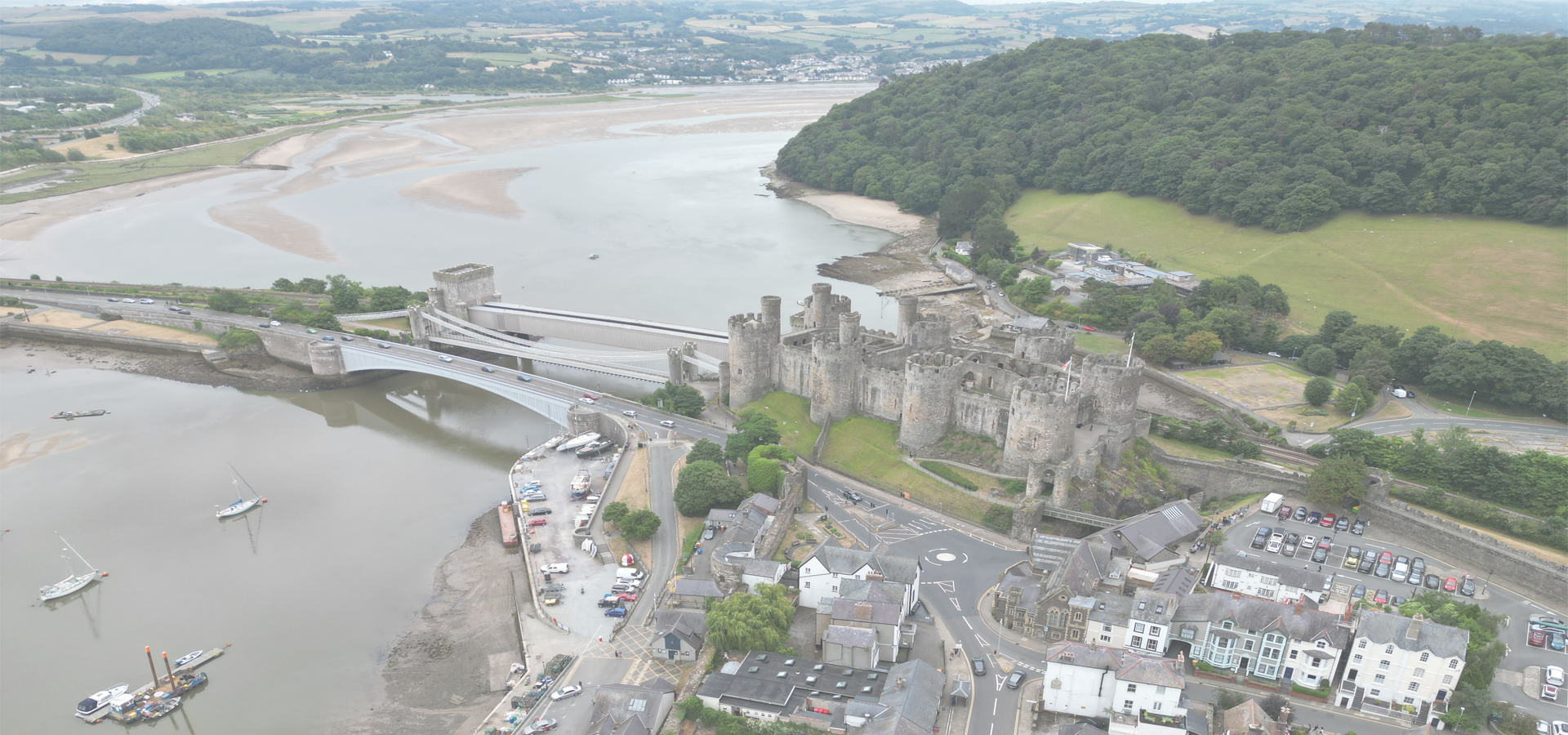🏴 🏴 Architect Clough Williams-Ellis is associated with Conwy. He was an active supporter of the National Trust, and the Council for the Protection of Rural England.
Conwy, Wales, United Kingdom
🏴 Conwy, previously known in English as Conway, is a walled market town and community in Conwy County Borough on the north coast of Wales. The town, which faces Deganwy across the River Conwy, formerly lay in Gwynedd and prior to that in Caernarfonshire. The community, which includes Deganwy and Llandudno Junction, is a popular tourist destination.
The name 'Conwy' derives from the old Welsh words cyn (chief) and gwy (water), the river being originally called the 'Cynwy'.
Conwy Morfa, a marshy spit of land on the west side of the estuary, was probably the location where golf was first played on Welsh soil. It was also the place where Hugh Iorys Hughes developed, and later built, the floating Mulberry Harbour, used in Operation Overlord in World War II.
Conwy railway station bus stop has services to Llandudno, a four-hourly service to Holyhead, and a hop-on, hop-off tour bus, The Llandudno and Conwy Tour.
Conwy Castle and the town walls were built, on the instructions of Edward I of England, between 1283 and 1289, as part of his conquest of the principality of Wales. The church standing in Conwy has been marked as the oldest building in Conwy and has stood in the walls of Conwy since the 14th century. However, the oldest structure is part of the town walls, at the southern end of the east side. Here one wall and the tower of a llys (palace/court house) belonging to Llywelyn the Great and his grandson Llywelyn ap Gruffydd have been incorporated into the wall. Built on a rocky outcrop, with an apsidal tower, it is a classic, native, Welsh build and stands out from the rest of the town walls, due to the presence of four window openings. It dates from the early 13th century and is the most complete remnant of any of his llysoedd.
The walls are part of a World Heritage Site, Castles and Town Walls of King Edward in Gwynedd.
Abbey Conwy was the original site of Aberconwy Abbey, founded by Llywelyn the Great. Edward and his troops took over the abbey site and moved the monks up the Conwy valley to a new site at Maenan, establishing Maenan Abbey. The parish church St Mary's All Saints still retains some parts of the original abbey church in the east and west walls. English settlers were given incentives to move to the walled garrison town, which the Welsh were forbidden from entering for decades.
Suspension bridge Conwy has other tourist attractions. Conwy Suspension Bridge, designed by Thomas Telford to replace the ferry, was completed in 1826 and spans the River Conwy next to the castle. Telford designed the bridge's supporting towers to match the castle's turrets. The bridge is now open to pedestrians only and, together with the toll-keeper's house, is in the care of the National Trust.
Railway bridge The Conwy Railway Bridge, a tubular bridge, was built for the Chester and Holyhead Railway by Robert Stephenson. The first tube was completed in 1848, the second in 1849. The bridge is still in use on the North Wales Coast Line, along with the station, which is located within the town walls. In addition to a modern bridge serving the town, the A55 road passes under the river in a tunnel, Britain's first immersed tube tunnel, which was built between 1986 and 1991. The old mountain road to Dwygyfylchi and Penmaenmawr runs through the Sychnant Pass, at the foot of Conwy Mountain.
Conwy, Wales, United Kingdom

Conwy has a population of over 14,753 people. Conwy also forms the centre of the wider Conwy county which has a population of over 116,200 people.
To set up a UBI Lab for Conwy see: https://www.ubilabnetwork.org Twitter: https://twitter.com/UBILabNetwork
🏴 Ellesmere Port 53.278
🏴 Macclesfield 53.256
🇩🇪 Westerstede 53.25
🏴 Chesterfield 53.236
🇪🇸 Boadilla del Monte -3.867
🇪🇸 Majadahonda -3.867
🇪🇸 Las Rozas de Madrid -3.873
🇨🇮 Port-Bouet -3.9
🇪🇸 Ciudad Real -3.917
🏴 North Lanarkshire -3.922
🇲🇦 Al Hoceima -3.936
Locations Near: Conwy -3.83039,53.2808
🏴 Colwyn Bay -3.7,53.29 d: 8.7
🏴 Bangor -4.128,53.228 d: 20.7
🏴 Mold -3.146,53.171 d: 47.2
:0: Flintshire -3.142,53.168 d: 47.5
🏴 Wallasey -3.117,53.4 d: 49.2
🏴 Connah's Quay -3.057,53.218 d: 51.9
🏴 Holyhead -4.633,53.309 d: 53.4
🏴 Birkenhead -3.014,53.394 d: 55.6
Antipodal to: Conwy 176.17,-53.281
🇳🇿 Dunedin 170.474,-45.884 d: 19096.5
🇳🇿 Invercargill 168.373,-46.413 d: 19069.8
🇳🇿 Christchurch 172.617,-43.517 d: 18898.5
🇳🇿 Canterbury 171.58,-43.543 d: 18881.2
🇳🇿 Queenstown 168.658,-45.033 d: 18948.9
🇳🇿 Wellington 174.767,-41.283 d: 18676.9
🇳🇿 Hutt 174.917,-41.217 d: 18670.3
🇳🇿 Lower Hutt 174.917,-41.217 d: 18670.3
🇳🇿 Upper Hutt 175.05,-41.133 d: 18661.7
